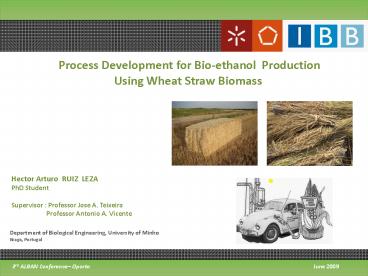Diapositiva 1 - PowerPoint PPT Presentation
1 / 15
Title:
Diapositiva 1
Description:
Hector Arturo RUIZ LEZA. PhD Student. Supervisor : Professor Jose A. Teixeira ... 3rd ALBAN Conference Oporto. Department of Biological Engineering, University ... – PowerPoint PPT presentation
Number of Views:40
Avg rating:3.0/5.0
Title: Diapositiva 1
1
Process Development for Bio-ethanol Production
Using Wheat Straw Biomass
Hector Arturo RUIZ LEZA PhD Student
Supervisor Professor Jose A. Teixeira
Professor Antonio A. Vicente
Department of Biological Engineering, University
of Minho Braga, Portugal
June 2009
3rd ALBAN Conference Oporto
2
Overview
Ethanol as Fuel ?
- In 1908 Henry Ford built Model T to run on
ethanol. - The energy crisis of the 1970s renewed the
interest in ethanol production for fuels and
chemicals.
3rd ALBAN Conference Oporto
3
The Market
2008 World Fuel Ethanol Production (17,206.89
Millions of Gallons)
Historic U.S.A. Fuel Ethanol Production
Source RFA, F.O. Licht 2008 Estimates
3rd ALBAN Conference Oporto
4
Different Technologies
2nd generation Lignocellulosic (Agricultural
Residues) Substrates (Stover, Straw, Wood
Bagasse etc.)
1st generation Starch Ethanol (Competing
with food) Substrates (Corn, Grain, Sugarcane
etc.)
Structure of Lignocellulosic Material
Lignin (phenolics)
Hemicellulose (xylose)
Cellulose (glucose)
3rd ALBAN Conference Oporto
5
OBJECTIVE
Optimize the production of second-generation
bioethanol using wheat straw biomass. The
integration of lignocellulosic biomass
pretreatments with the fermentation process will
be done with the aim of developing a simultaneous
saccharification and fermentation (SSF) process.
3rd ALBAN Conference Oporto
6
BIOCONVERSION OF BIOMASS TO ETHANOL
Optimization Done
Solubilization of Hemicellulose
Hydrothermal treatment Autohydrolysis
Wheat Straw
Size Reduction
Simultaneous saccharification and fermentation
(SFF)
Fermentation (Conversion of sugar to bioethanol)
Enzymatic hydrolysis (Conversion of cellulose to
sugar)
Distillation and evaporation
Residue Processing
Co-products
Bioethanol
3rd ALBAN Conference Oporto
7
Hydrothermal Treatment (Autohydrolysis)
- Variables
- Severity conditions
- Particle Size
- Advantages
- Is an environmentally friendly process
- Hemicellulose can be converted into
hemicellulosic sugar - (xylose principally and the others glucose,
arabinose) - Low byproduct generation (inhibitors)
- No chemicals other than water are necessary
- No problems derived from equipment corrosion
3rd ALBAN Conference Oporto
8
Results
Composition of wheat straw ( of dry
weight)
a Measured as glucan
3rd ALBAN Conference Oporto
9
Results
a)
b)
c)
d)
e)
f)
Relation between severity parameters and variance
of hydrolyzed sugars () a) Xylose b)
arabinose c) glucose d) acetic acid, e) HMF
and f) furfural. Variance values 0.103(?) 0.061
(?) 0.049 (?).
10
Results
Optimization of Hydrothermal treatment
(autohydrolysis)
Autohydrolysis of wheat straw has the aim of
maximize the extraction of hemicellulose
evaluated by the sum of glucose, xylose and
arabinose molar concentration on the
liquor. Resident time and temperature had a
significative effect on the total sugar sum. The
relation variance-temperature suggest that the
sugar hydrolysis is more favored when this ratio
decreases.
This effect can be described by the following
model
Where Var is the variance t is residence time
(min) T is temperature (oC) a, b, c, d, e and
f are estimated parameter
3rd ALBAN Conference Oporto
11
Conclusions
Blends particle size in function of the variance
demonstrated that have a selective influence over
the solubilization of wheat straw sugars under
the autohydrolysis pretreatment.
Thus, it can be establish that the use of a blend
with defined percentage is an important parameter
to be defining before carried out a pretreatment
in order to improve the disable monosaccharide
recovery.
3rd ALBAN Conference Oporto
12
BIOCONVERSION OF BIOMASS TO ETHANOL
Optimization Done
Solubilization of Hemicellulose
Hydrothermal treatment Autohydrolysis
Wheat Straw
Size Reduction
Simultaneous saccharification and fermentation
(SFF)
Future Work
Fermentation (Conversion of sugar to bioethanol)
Enzymatic hydrolysis (Conversion of cellulose to
sugar)
Distillation and evaporation
Residue Processing
Co-products
Bioethanol
3rd ALBAN Conference Oporto
13
ACKNOWLEDGEMENTS
The authors thanks to
European Union Programme of High Level
Scholarships for Latin America Dr. Denise S.
Ruzene Dr. Mafalda Quintas Dr. Daniel P. Silva
3rd ALBAN Conference Oporto
14
Thanks for your attentions
3rd ALBAN Conference Oporto
15
Appendix
3rd ALBAN Conference Oporto































